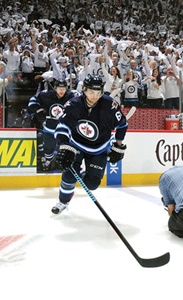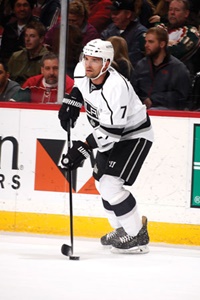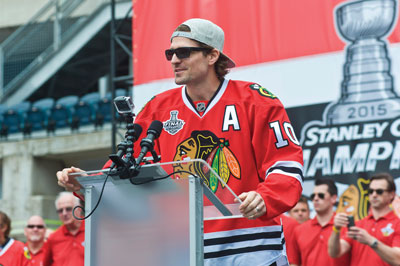On the first day of NHL free agency, agent Allan Walsh received many calls and offers from clubs on unrestricted free agents Andrej Sekera and Michael Frolik, but not one of them came from New York, Los Angeles or Chicago.
“There were upwards of eight offers on Sekera and six offers on Frolik,” said Walsh, one of two co-directors of Octagon Hockey.
 |
|
 |
Michael Frolik (left) and Andrej Sekera signed the two biggest deals on the first day of free agency, but such big-number contracts were slow coming out of the gate.
Photo by: GETTY IMAGES (2)
|
In the end, defenseman Sekera signed a six-year, $33 million deal with the Edmonton Oilers, and right wing Frolik signed a five-year, $21.5 million deal with the Calgary Flames, the two biggest deals on the opening day of free agency. Sekera’s and Frolik’s deals were the only two contracts that were at least five years in length and worth at least $20 million signed on the first day of free agency this year, versus seven such contracts on the first day of free agency last year, according to CBS Sports.
Walsh said the number of clubs bidding on his players was a bit light, but in his 20-year career as a hockey agent, he could not remember the biggest markets sitting out the process.
“I don’t think the big-market teams have — in the same summer — been without available cap space at the same time,” Walsh said. “I think the big-market teams, like Chicago, L.A. and the New York Rangers, those teams had a history of driving the free agent market.”
Unlike the NBA, where clubs are spending big dollars on what are seen to be average players because of a rising salary cap and projections for even bigger increases, the NHL is in a cap-stressed market, and those big-market teams have been left with little room to maneuver. The NHL salary cap is $71.4 million in 2015-16, up from $69 million last season, but the hockey world had anticipated that the cap would be higher for 2015-16 when clubs were making deals a few years ago. A decline in the value of the Canadian dollar kept the cap lower than expected.
“The fact that the Canadian currency went down about 18 to 20 percent did not help the [hockey-related revenue, on which the cap is based], so therefore the cap only went up about $1.5 million instead of possibly $3.5 million to $4 million,” CAA Hockey co-head Pat Brisson wrote in a text. “It pushes teams at the top of the financial pyramid to have to move assets in order to make space under the cap.”
 |
Salary cap pressure forced the Blackhawks to trade alternate team captain Patrick Sharp.
Photo by: GETTY IMAGES
|
For example, the Stanley Cup champion Chicago Blackhawks were forced to trade alternate team captain Patrick Sharp, who carried a $5.9 million salary cap hit, to the Dallas Stars, and 22-year-old rising star wing Brandon Saad to the Columbus Blue Jackets.
Walsh noted that the Los Angeles Kings gave up this year’s first-round draft pick to sign Sekera. “They loved him,” Walsh said. “They desperately wanted him to stay. They didn’t have the cap space to make an offer.”
Free agency begins July 1 and technically doesn’t end until the trade deadline the next March. But as a practical matter, the vast majority of free agents sign by the beginning of the NHL season in the first week of October. The best free agents typically sign in the first five days and usually on the first day.
Asked about this summer’s market, NHL Deputy Commissioner Bill Daly said, “The system is operating the way it was intended to operate.” He declined further comment. The NHL Players’ Association declined to comment.
Veteran agent Neil Sheehy noted the scarcity of premium free agents on the market this year, but that in part is because clubs are signing young players to longer-term deals as restricted free agents as well as locking up other core players before they get to unrestricted free agency.
Some of the biggest deals in this summer’s market have been for restricted free agents, as well as extensions for core players. The Anaheim Ducks last week signed star center Ryan Kesler to a six-year, $41.25 million extension, one year before he would have become an unrestricted free agent.
“Several NHL teams are in a situation where managing their respective payrolls has become a bit of a shell game where they must try to protect core players, but also remain competitive,” said Kurt Overhardt, Kesler’s agent and owner of KO Sports. “We have seen some teams have to dismantle somewhat and adjust on the ice, while others are in a race to become competitive and are adding assets and additional payroll within the salary cap limits. It is truly the game within the game.”
Despite the number of clubs locked out of the market with no room under the cap, Octagon had a very good free agency, negotiating seven restricted and unrestricted free agent contracts with a total value of $173.4 million.
Octagon Hockey co-director Mike Liut negotiated an eight-year, $60 million contract for 23-year-old Vladimir Tarasenko to stay with the St. Louis Blues, four years before Tarasenko would have become a free agent.
Liut said he believes the deal fairly reflects a blend of Tarasenko’s value as a restricted free agent and an unrestricted free agent over that time period.
The NHL now has operated under a salary cap since the 2005-06 season, and Liut noted that teams were adjusting to the new system in its early years. “We have now a fully functioning salary cap environment,” Liut said. “We’ve had seven or eight years of this thing really developing such that most teams have laid their bets with their star players. That’s essentially where your core players are: locked in and locked down.”







